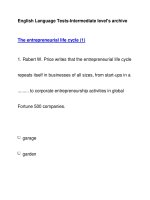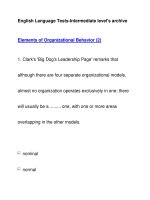English Language Tests-Intermediate level''''s archiveThe entrepreneurial life cycle (2): The seven doc
Bạn đang xem bản rút gọn của tài liệu. Xem và tải ngay bản đầy đủ của tài liệu tại đây (76.46 KB, 8 trang )
English Language Tests-Intermediate level's archive
The entrepreneurial life cycle (2): The seven stag
1. Opportunity Recognition: This period is quite literally the
'pre-start' analysis; it often occurs over a considerable period of
time ranging from one month to ten years.
degustation
digression
generation
gestation
2. Opportunity Focusing: This is a 'sanity check', a go/no-go stage
gate for part-time entrepreneurs because it out shaky ideas
and exposes gaping holes.
fades
fixes
fleshes
forms
3. It is important to include objective, viewpoints because
different people can investigate the same opportunity and come to
opposite conclusions.
exterior
extraneous
outer
outside
4. Commitment of Resources: Most entrepreneurs see
commitment as incorporating their business or quitting their
job.
day
good
only
real
5. But this stage actually starts with developing the business plan;
the process will take between 200 to 300 hours, so squeezing that
amount of time evenings and weekends can make this
stage stretch over three to twelve months.
into
out of
over
through
6. Market Entry: The entrepreneur is committed with a very simple
organization, the resources were correctly according to the
business plan, and the first sales were made.
allocated
disbursed
reimbursed
relocated
7. If the business model was profitable, reasonable objectives
were met, and the venture is on track for attaining true economic
health, then the entrepreneur can chose between a capital
for growth or remaining small with self-financing.
infusion
insertion
insurgence
intrusion
8. Full Launch and Growth: Or the venture could remain small, for
the simple fact that not all small ventures can or will become big
companies; they are not fast growth potential because there is not
enough room in the market for growth or their production and
management systems are not
feasible
forcible
saleable
scalable
9. Maturity and Expansion: Now the venture is a market leader at
cruising altitude; this professional management team is
implementing the venture's growth strategy through global
expansion, acquisitions, and mergers as cash is plentiful and
inefficiencies are completely out.
flushed
rinsed
washed
wrung
10. Liquidity Event: This stage is focused on capturing the
value created in the previous stages through a business exit;
typical exits are an initial public offering or being acquired by a
larger publicly traded corporation.
cultivating
harvesting
harrowing
seeding









